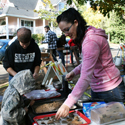Digging Jacksonville – June 2015
Chinese immigrants were an important part of early Jacksonville. Despite this, they were often victims of racist stereotypes both during the occupation of the Chinese Quarter, and today, through misrepresentations (or omissions) in the history of the American West. While this is part of a much larger discussion, some of the seeds of this cultural misunderstanding arose from the Chinese reliance on traditional foods, which differed greatly from that commonly found on Euro-American tables. During the excavation of the Chinese Quarter Site, a large volume of faunal material was recovered that included animal, bird, and fish bones from a variety of species. One of the highlights of the collection so far, was a butchered bear tibea (lower leg bone). While newspapers and journals indicate that bear was a fairly common food consumed in Jacksonville by a variety of people, the bone has a special connection to long-held traditions in Canton, China.
In traditional Chinese cuisine, bear paw was a delicacy served to the imperial and elite classes during large banquets. Extravagant meals where rare foods were served acted to confirm one’s status and display one’s prominence and wealth, as these items were difficult and expensive to obtain. Many of the bear paws that graced these formal tables were imported from the American west, where bears were abundant and in some cases, perceived as a nuisance to early settlers. While different foods were used during these feasts, bear paw stands out as a particularly-important status marker reserved for the highest class.
The presence of the bear tibia at the Jacksonville Chinese Quarter site suggests that the tradition could have come over to Oregon with the Chinese immigrants living in the area. While Jacksonville’s early census indicates that the Chinese Quarter residents held a range of occupations (from miner, cook, gambler, laundry man, to butcher, and merchant), presumably none of the early occupants were from the elite class that would have been consuming bear paws. While bear was a rare commodity in China, black and brown bear were very common in the Applegate and Rogue River valleys and are documented as a food source by Euro-Americans as well as the Chinese populations of the region. The presence of the butchering marks on the bear tibia is interesting as well, as they indicate the bear was butchered using traditional Euro-American cuts. However, the tibia cut would have been to remove the lower leg and foot from the roast (the desired part). However, the presence of the lower tibea bone in the Chinese Quarter assemblage suggests that this portion was being consumed.
It is possible that the availability of these traditionally-rare and esteemed foods may have led to the adoption and adaptation of these dishes. While the abundance of the bear in the region may have resulted in them becoming an affordable food source for the Chinese populations of Jacksonville, the bone cut suggests that they could be preparing bear in traditional Chinese fashion. Therefore, the presence of the bear paw in the assemblage from the Chinese Quarter site of Jacksonville could reflect the blending of traditional cultural foodways with locally available foods, thus creating new food traditions on the Oregon frontier.
The excavations in the Jacksonville Chinese Quarter were funded by the City of Jacksonville and the Oregon Department of Transportation.

 Katie Johnson is a staff archaeologist at the Southern Oregon University Laboratory of Anthropology. Katie will be directing the analysis of the several thousand animal and fish bones recovered from the Jacksonville Chinese Quarter Site. You can reach SOULA by contacting Chelsea Rose at rosec@sou.edu and follow SOULA on
Katie Johnson is a staff archaeologist at the Southern Oregon University Laboratory of Anthropology. Katie will be directing the analysis of the several thousand animal and fish bones recovered from the Jacksonville Chinese Quarter Site. You can reach SOULA by contacting Chelsea Rose at rosec@sou.edu and follow SOULA on